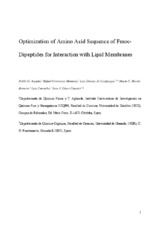Mostrar el registro sencillo del ítem
Optimization of Amino Acid Sequence of Fmoc-Dipeptides for Interaction with Lipid Membranes
| dc.contributor.author | Argudo, Pablo G. | |
| dc.contributor.author | Contreras-Montoya, Rafael | |
| dc.contributor.author | Álvarez de Cienfuegos, Luis | |
| dc.contributor.author | Camacho, Luis | |
| dc.contributor.author | Giner-Casares, Juan J. | |
| dc.contributor.author | Martín-Romero, M.T. | |
| dc.date.accessioned | 2019-09-23T12:43:12Z | |
| dc.date.available | 2019-09-23T12:43:12Z | |
| dc.date.issued | 2019 | |
| dc.identifier.uri | http://hdl.handle.net/10396/19005 | |
| dc.description.abstract | Fmoc-dipeptides appear as highly relevant building blocks in smart hydrogels and nanovehicles for biological applications. The interactions of the Fmocdipeptides with the cell membrane determine the efficiency of the nanomaterials based on the Fmoc-dipeptides’ internalization of nanovehicles for drug delivery. Here, we aim to understand the interplay of the interactions between the Fmoc-dipeptides and a phospholipid surface as a function of the amino acid sequence. The DMPA (1,2-dimyristoyl-snglycero- 3-phosphate) phospholipid in Langmuir monolayers was used as a model cell surface. A set of seven derivatives of Fmoc-dipeptides with a broad range of hydrophobicity were included. Mixed monolayers composed of DMPA/Fmoc-dipeptides in an equimolar ratio were built and characterized in situ at the air/water interface. Surface pressure−molecular area isotherms (π−A), Brewster angle microscopy (BAM), and UV−vis reflection spectroscopy (ΔR) were combined to provide a holistic picture of the interactions of the Fmoc-dipeptide with the phospholipid molecules. An increase in the hydrophobicity led to enhanced interaction of the Fmoc-dipeptide and DMPA molecules. The compression of the mixed monolayer could displace a significant fraction of the Fmoc-dipeptide from the monolayer. High hydrophobicity promoted self-assembly of the Fmoc-dipeptides over interaction with the phospholipid surface. The interplay of these two phenomena was analyzed as a function of the amino acid sequence of the Fmoc-dipeptides. The toxicity effect of Fmoc-FF could be observed and detailed at the molecular level. This study suggests that the adjustment of the hydrophobicity of the Fmoc-dipeptides within a defined range might optimize their efficiency for interaction with the lipid membranes. A semiquantitative guide for the chemical design of Fmoc-dipeptides for biological applications is proposed herein. | es_ES |
| dc.format.mimetype | application/pdf | es_ES |
| dc.language.iso | eng | es_ES |
| dc.publisher | ACS Publications | es_ES |
| dc.rights | https://creativecommons.org/licenses/by-nc-nd/4.0/ | es_ES |
| dc.source | The Journal of Physical Chemistry B 123, 3721-3730 (2019) | es_ES |
| dc.subject | Dipéptidos | es_ES |
| dc.subject | Autoensamblaje | es_ES |
| dc.subject | Nanotecnología | es_ES |
| dc.subject | Monocapas | es_ES |
| dc.title | Optimization of Amino Acid Sequence of Fmoc-Dipeptides for Interaction with Lipid Membranes | es_ES |
| dc.type | info:eu-repo/semantics/article | es_ES |
| dc.relation.publisherversion | http://dx.doi.org/10.1021/acs.jpcb.9b01132 | es_ES |
| dc.relation.projectID | Gobierno de España. CTQ2017-83961-R | es_ES |
| dc.relation.projectID | Gobierno de España. FIS2017-85954-R | es_ES |
| dc.relation.projectID | Gobierno de España. RyC-2014-14956 | es_ES |
| dc.rights.accessRights | info:eu-repo/semantics/openAccess | es_ES |

